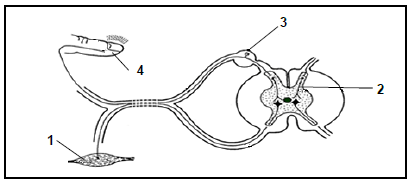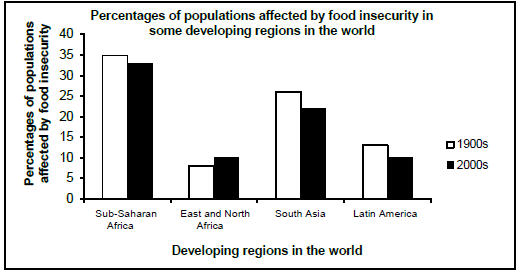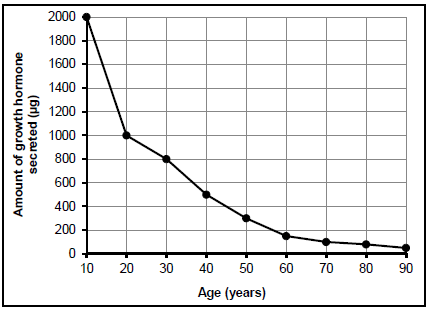LIFE SCIENCES PAPER 1 QUESTIONS GRADE 12 - NSC PAST PAPERS AND MEMOS NOVEMBER 2016
Share via Whatsapp Join our WhatsApp Group Join our Telegram GroupLIFE SCIENCES P1
GRADE 12
NATIONAL SENIOR CERTIFICATETIME
NOVEMBER 2016.
INSTRUCTIONS AND INFORMATION
Read the following instructions carefully before answering the questions.
- Answer ALL the questions.
- Write ALL the answers in the ANSWER BOOK.
- Start the answers to EACH question at the top of a NEW page.
- Number the answers correctly according to the numbering system used in this question paper.
- Present your answers according to the instructions of each question.
- Make ALL drawings in pencil and label them in blue or black ink.
- Draw diagrams, tables or flow charts only when asked to do so.
- The diagrams in this question paper are NOT necessarily drawn to scale.
- Do NOT use graph paper.
- You must use a non-programmable calculator, protractor and a compass, where necessary.
- Write neatly and legibly.
SECTION A
QUESTION 1
1.1 Various options are provided as possible answers to the following questions. Write down the question number (1.1.1 to 1.1.10), choose the answer and make a cross (X) over the letter (A to D) of your choice in the ANSWER BOOK.
EXAMPLE: ![]()
1.1.11 The part of the brain that receives nerve impulses from the semi-circular canals in the....
- cerebrum.
- cerebellum.
- hypothalamus.
- medulla oblongata.
1.1.2 A light stimulus is converted into a nerve impulse in the ...
- iris.
- retina.
- optic nerve.
- sclera.
1.1.3 A human somatic cell has …
- 46 autosomes and 2 gonosomes.
- 2 autosomes and 44 gonosomes.
- 44 autosomes and 2 gonosomes.
- 23 autosomes and 23 gonosomes.
1.1.4 Which ONE of the following statements is CORRECT regarding the eyes represented in the diagrams below?

- Diagram A is looking at an object closer than 6 metres, while diagram B is looking at an object further than 6 metres.
- Diagram A is looking at an object further than 6 metres, while diagram B is looking at an object closer than 6 metres.
- The eye in diagram A is in dim light and the eye in diagram B is in bright light.
- The eye in diagram A is in bright light and the eye in diagram B is in dim light.
1.1.5 The diagram below shows a reflex arc.

Which part represents the effector?
- 4
- 1
- 3
- 2
1.1.6 A person with middle-ear infection is usually advised not to fly in an aeroplane because the …
- maculae in the semi-circular canals are unable to receive the stimulus.
- round window is unable to absorb sound waves, leading to echoes.
- Eustachian tube is unable to equalise the pressure on either side of the tympanic membrane.
- optic nerve will be damaged, leading to hearing loss.
1.1.7 The graph below shows the percentages of populations affected by food insecurity in some developing regions in the world.

Which ONE of the above regions does NOT show improvement in its food security for the period shown?
- Latin America
- Sub-Saharan Africa
- East and North Africa
- South Asia
QUESTIONS 1.1.8 AND 1.1.9 REFER TO THE INVESTIGATION BELOW.
A scientist did an investigation on a healthy individual to determine the effect of drinking water on urine production.
The participant was requested not to eat or drink for four hours before the investigation began. The investigation was conducted over a period of three days.
The procedure was as follows:
- On day 1 the participant was given 600 mℓ of water to drink.
- On day 2 the participant was given 800 mℓ of water to drink.
- On day 3 the participant was given 1 000 mℓ of water to drink.
- For each day the amount of urine produced by the participant was measured and recorded over the next four hours, and an average was calculated.
1.1.8 Which ONE of the following CORRECTLY indicates the dependent and the independent variables?
| INDEPENDENT VARIABLE | DEPENDENT VARIABLE | |
| A | The amount of urine produced | Time in hours |
| B | The amount of water drunk | The amount of urine produced |
| C | The amount of urine produced | The amount of water drunk |
| D | The people participating | Time in hours |
1.1.9 The list below contains some steps taken before and during the investigation.
- Permission was obtained to participate in the investigation.
- The measuring tool to be used was decided upon.
- Water was given to the participant to drink.
- The amount of urine produced was measured.
Which of the steps above can be considered as part of the planning steps before conducting the investigation?
- (i), (ii), (iii) and (iv)
- (i) and (ii) only
- (ii), (iii) and (iv) only
- (iii) only
1.1.10 The graph below shows the relationship between the production of growth hormone and age.

A general conclusion that can be drawn from the results is that …
- growth hormone is not secreted after the age of 50 years.
- the amount of growth hormone secreted decreases with age.
- the amount of growth hormone secreted increases with age.
- the amount of growth hormone secreted remains stable over time. (10 x 2) (20)
1.2 Give the correct biological term for each of the following descriptions. Write only the term next to the question number (1.2.1 to 1.2.8) in the ANSWER BOOK.
1.2.1 The phase in the cell cycle when DNA replication occurs
1.2.2 The part of the peripheral nervous system that controls involuntary actions
1.2.3 A plant hormone that causes leaves to fall off trees in autumn
1.2.4 Measurement of the total amount of carbon dioxide emissions of an individual per year
1.2.5 The division of the cytoplasm through the constriction of the cell membrane at the end of cell division
1.2.6 The structure in the amniotic egg that stores wastes
1.2.7 The inner lining of the uterus where implantation of the embryo occurs
1.2.8 Part of the female reproductive system where fertilisation occurs (8 x 1) (8)
1.3 Indicate whether each of the descriptions in COLUMN I applies to A ONLY, B ONLY, BOTH A AND B or NONE of the items in COLUMN II. Write A only, B only, both A and B or none next to the question number (1.3.1 to 1.3.3) in the ANSWER BOOK.
| COLUMN I | COLUMN II |
| 1.3.1 Female frogs lay eggs in water and the males spray sperm onto the eggs. | A:Vivipary B:Ovovivipary |
| 1.3.2 The phase of meiosis when independent assortment occurs | A:Anaphase II B:Metaphase I |
| 1.3.3 The type of development in vertebrates where the young are well developed and able to move at birth | A:Precocial development B:Altricial development |
(3 x 2) (6)
1.4 The diagrams below represent some phases of meiosis in an animal cell.

1.4.1 Identify the following parts in Diagram 3:
- A(1)
- B(1)
- C(1)
1.4.2 Using the diagram NUMBERS (1, 2, 3, 4) showing some of the phases, arrange the diagrams above in the sequence as they occur during meiosis.(2)
1.4.3 How many chromosomes were in the cell before meiosis began?(1)
(6)
1.5 The schematic diagram below shows a human ovum that is about to be fertilised. The diagram is not drawn to scale.

1.5.1 Identify part:
- A(1)
- B(1)
- C(1)
- F(1)
1.5.2 Give the LETTER and NAME of the part that:
- Contains the mitochondria(2)
- Contains enzymes required to penetrate the ovum(2)
- Will enter the ovum during fertilisation(2)
(10)
TOTAL SECTION A: 50
SECTION B
QUESTION 2
2.1 The diagram below represents the human male reproductive system.

2.1.1 Identify part A. (1)
2.1.2 Write down the LETTERS only of TWO parts that contribute to the formation of semen.(2)
2.1.3 Explain the consequence on human reproduction if a male wears tight-fitting underwear all the time.(3)
(6)
2.2 A fertility monitor measures the concentration of oestrogen and luteinising hormone (LH) in a woman's urine. A fertile period is the time when the ovum is ready to be fertilised.
The graph below appears on the information sheet that is provided with the fertility monitor.

2.2.1 Name the gland that secretes LH.(1)
2.2.2 Explain why the fertility monitor measures the concentration of LH.(2)
2.2.3 Explain why some women would use a fertility monitor. (2)
2.2.4 What evidence in the graph indicates that a healthy follicle is developing in the ovary during the first half of the cycle? (2)
2.2.5 If a woman using the fertility monitor finds that her LH level peaks on day 17, between which days does she experience the 'highest fertility'?(2)
2.2.6 Explain why the fertility monitor does not measure the progesterone level in the blood to predict fertile days. (3)
(12)
2.3 An investigation was carried out to determine the effect of caffeine on body temperature and pulse rate. A group of 200 men participated in the investigation.
The procedure was as follows:
- At the start of the investigation each man's body temperature was measured, and the average of all the participants was calculated.
- Also, at the start of the investigation each man's pulse rate was measured, and the average of all the participants was calculated.
- The men each drank 100 mℓ of an energy drink containing the same amount of caffeine.
- Their body temperature was then measured every 15 minutes for a period of 1 hour, and an average of all the participants was calculated.
- Also, their pulse rate was then measured every 15 minutes for a period of 1 hour, and the average of all the participants was calculated.
- All the participants were seated during the period of investigation.
- The table below shows the results of the investigation.Hormone level
| TIME (minutes) | AVERAGE TEMPERATURE (°C) | AVERAGE PULSE RATE (BPM) |
| 0 | 36,6 | 76 |
| 15 | 37,4 | 91 |
| 30 | 38 | 95 |
| 45 | 37,8 | 89 |
| 60 | 37,4 | 89 |
2.3.1 Describe the effect that caffeine had on body temperature and pulse rate after 15 minutes.(2)
2.3.2 How long after drinking the energy drink did the caffeine have its maximum effect?(1)
2.3.3 Caffeine causes vasoconstriction and an increase in metabolism.Explain how these effects contribute to the temperature change that occurred.(4)
2.3.4 State TWO factors that were kept constant during this investigation.(2)
(9)
2.4 Describe how the blood glucose level in the human body is returned to normal when the glucose level decreases to below normal. (4)
2.5 The diagram below shows the results of an investigation carried out to determine the effect of auxins on the growth of coleoptiles (young shoots).
The procedure was as follows:
- Three coleoptiles were used.
- Coleoptile A had its apical bud removed.
- Coleoptile B had its apical bud covered with a black plastic cover.
- Coleoptile C had its apical bud covered with a transparent plastic cover.
- All three coleoptiles (A, B and C) were then exposed to unilateral sunlight.
The diagram below shows the results of the investigation.

2.5.1 Explain the results obtained, as shown by coleoptile:
- B(3)
- C(4)
2.5.2 Explain why lateral branches will develop in coleoptile A. (2)
(9)
[40]
QUESTION 3
3.1 The diagram below represents a neuron in a human.

3.1.1 Identify the type of neuron represented in the diagram.(1)
3.1.2 State ONE function of part B.(1)
3.1.3 Explain the role of part C in the functioning of the neuron.(2)
3.1.4 Explain the consequence for a reflex action if the neuron shown in the diagram is damaged. (2)
(6)
3.2 The diagram below illustrates how light refracted in the human eye leads to a visual defect.

3.2.1 Identify part:
- B (1)
- C (1)
3.2.2 Name the visual defect that is illustrated in the diagram.(1)
3.2.3 Describe the consequences of the visual defect in your answer to QUESTION 3.2.2.(2)
3.2.4 Explain the consequences if the light rays were to fall on part A.(3)
3.2.5 Explain TWO ways in which the lens is structurally suited to perform its function. (4)
(12)
3.3 Read the extract about GMOs below.
| Some fruits are usually harvested when they reach maturity and then undergo rapid ripening during storage and transportation. Others have to be harvested only when they are fully ripened. Normally farmers pick their produce while it is still green. However, fruits harvested prematurely (too early) tend to be poor in taste and their quality decreases as they are refrigerated and transported over long distances. A strategy used nowadays is to genetically modify the fruit trees by introducing a gene from another organism that delays the ripening process. |
3.3.2 Explain why the growth of these GM fruit trees will economically benefit the:
- Consumer(2)
- Farmer(2)
3.3.1 According to the extract, state TWO disadvantages for farmers if they pick their produce prematurely. (2)
3.3.3 State TWO factors that, due to climatic changes, have a negative effect on food security. (2)
(8)
3.4 Read the extract below, which provides information on gasohol.
| Petrol is a fuel produced from crude oil. When petrol is burnt in engines it releases pollutants and greenhouse gases into the atmosphere. Since the early 1970s there has been a shortage of crude oil causing an 'oil crisis'. Petrol releases 34,8 megajoules of energy per litre. Gasohol is a mixture of 10% ethanol and 90% petrol. It can be used in most car engines without making any changes to the engine. It releases 23,5 megajoules of energy per litre. Gasohol is used in several countries. The use of gasohol can reduce carbon monoxide emissions by 20% to 30%. It can also decrease greenhouse gas emissions by an estimated 2% compared to using regular petrol. Ethanol evaporates easily and can increase certain atmospheric pollutants in warmer weather. The ethanol in gasohol is often obtained by fermenting sugar cane or maize. Ethanol made from maize is expensive and energy-intensive to produce. It is also important that the percentage ethanol should be correct, because if it is too high, it can damage rubber seals and paint on vehicles. |
3.4.1 State TWO advantages of using gasohol rather than petrol.(2)
3.4.2 Calculate the difference in the energy (in megajoules) released by petrol compared to that of gasohol. Show ALL working.(2)
3.4.3 Explain why the use of gasohol is regarded as a solution to the 'oil crisis'.(2)
3.4.4 Explain why it is better to use gasohol in countries with colder climates.(3)
3.4.5 Suggest ONE reason why food products such as sugar cane and maize should NOT be used to produce fuel.(1)
(10)
3.5 Describe how thermal pollution can impact on the quality of water and biodiversity. (4)
[40]
TOTAL SECTION B: 80
SECTION C
QUESTION 4
While walking in the bush Paul hears a sound which he thinks is the roar of a lion. He immediately runs to safety.
Describe how he hears the sound and describe the role of adrenalin to ensure that his muscles are able to function efficiently while he runs away.
Content: (17)
Synthesis: (3)
(20)
NOTE:
NO marks will be awarded for answers in the form of flow charts, tables or diagrams.
TOTAL SECTION C:20
GRAND TOTAL:150